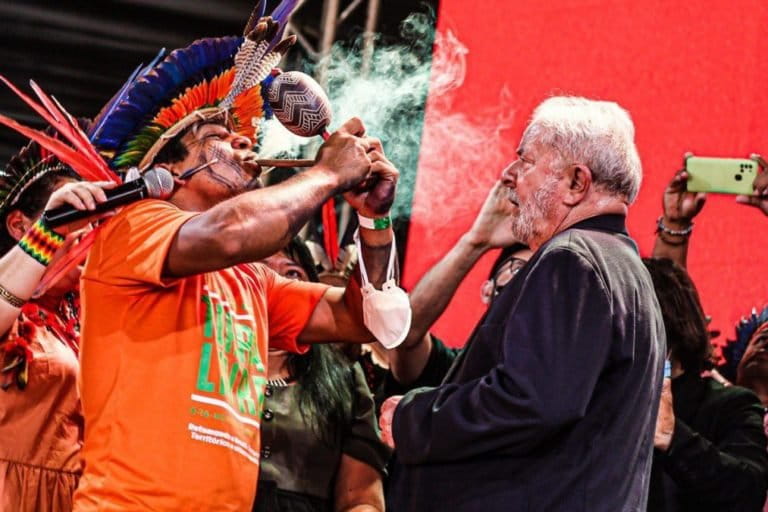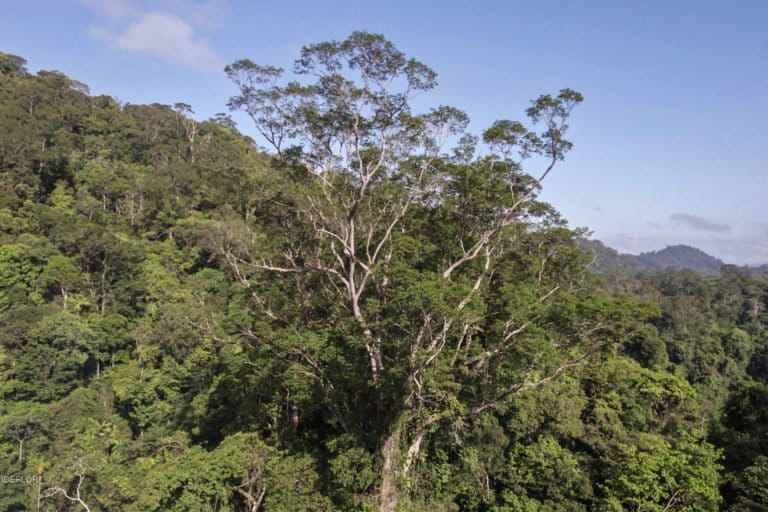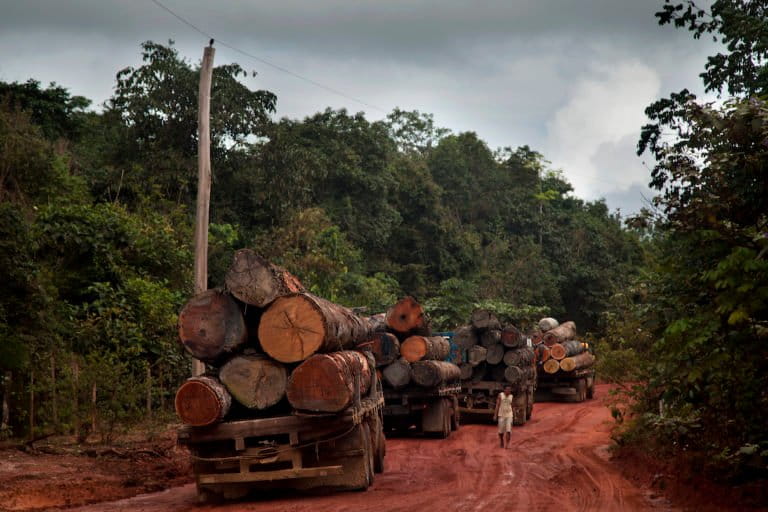- On Friday, Brazilian President Lula visits President Biden in Washington, D.C., to discuss topics including the U.S. joining the multilateral Amazon Fund, aimed at fighting deforestation in Brazil: a commitment could be announced during the meeting.
- In the early 2000s, then President Lula’s Brazil slowed Amazon deforestation, designating 60 million acres of new protected areas and Indigenous territories, mounting anti-deforestation law enforcement operations, and cutting off farm credit to landowners who leveled forests illegally.
- The U.S. joining the Amazon Fund would be very important, but a genuine partnership is about more than money, a new op-ed argues: “The U.S. and Brazil should share their cutting-edge science, technology and data to monitor forests. Both sides have world-class space agencies and innovations to track and manage land use,” they write.
- This post is a commentary. The views expressed are those of the authors, not necessarily of Mongabay.
Two days after the two-year anniversary of the January 6 riot at the U.S. Capitol, copycat mayhem broke out in Brazil’s own capital, Brasília. On that Sunday, newly-inaugurated Brazilian President Luiz Inácio Lula da Silva was visiting the flood-ravaged city of Araraquara when he learned of the destruction unfolding inside the Brazilian Congress, Supreme Court, and Presidential Palace. He went on TV to condemn the “fascists” who hoped to reverse Brazil’s election.
Arguably the most impassioned moment of his speech has been almost entirely overlooked in the international press: Lula linked the local floods to the capital riots via climate change, greed, and authoritarianism, and he condemned the cutting of old-growth forest with a vehemence seldom heard from heads of state.
“When people believe that climate change is a minor issue, when they think that it’s something for students, that it’s a left-winger’s cause, that it’s a concern for the Green Party, no! The climate is changing because of human beings’ irresponsibility,” the president declared, suggesting that forest destroyers were among the rioters. “A private citizen has no right to cut down a 300-year-old tree in the Amazon that belongs to each and every one of the 215 million Brazilians, just so he can make some money.”

Lula’s words remind us that the U.S. and Brazil have more than conspiracy theories and riots in common. We have major responsibilities, abilities, and apparent readiness to save our planet. And we have the next two years—with both Lula and Joe Biden in office—to do it.
Earth’s 10 hottest years have occurred since 2010 amid a simultaneous biodiversity crisis. Wild animal populations have declined by an average of 69% in the last 50 years. Brazil is crucial to solving these intertwined crises because it holds 65% of the Amazon, the globe’s biggest, most diverse, most intact tropical forest. The Brazilian Amazon stores around 42 billion tons of carbon, equivalent to four-decades-worth of global carbon emissions.
In the early 2000s, Lula’s Brazil showed the world how to stop deforestation. The country designated 60 million acres of new protected areas and Indigenous territories, an expanse the size of Oregon. They mounted aggressive law enforcement operations and cut off farm credit to landowners who deforested illegally. These and other measures reduced deforestation by 80% between 2004 and 2012.
That trend faltered under subsequent administrations. Deforestation, illegal mining, and attacks on environmental and Indigenous leaders rose, then spiked; Jair Bolsonaro presided over a 60% jump in deforestation, and a 90% increase in illegal gold mining. Social conflicts and violence accompanied the sacking of the forest.
Here’s what Brazil needs to do now: the country has 124 million acres of public rainforest whose use has never been decided. These areas are targeted and deforested by land grabbers. The public forests should be designated as conservation areas and Indigenous lands. An additional 49 million acres can be kept intact by helping small-scale landowners produce more in areas already deforested. Larger landowners can be encouraged to maintain another 42 million acres through economic incentives.
Indigenous peoples officially control 23% of the Brazilian Amazon and achieve the lowest rates of forest loss. Lula’s government, with its new Ministry for Indigenous Peoples, immediately announced final approval of 13 territories frozen under Bolsonaro. It needs to resolve the backlog of over 228 additional Indigenous land claims, which total more than 23 million acres. And Brazil must resume its formerly exemplary protection of its “uncontacted” Indigenous peoples, over 100 groups (29 officially recognized) living in the most intact parts of the Brazilian rainforest.
See related: Study shows that cutting down the Amazon does not build prosperity for most Brazilians

Finally, the new government must not undo all this progress by pushing new roads and dams into the forest.
The U.S. should help fund Amazon conservation. Global wellbeing depends on a protected Amazon. Some rich governments have stepped up, led by Norway, which gave $1 billion for the Brazilian Amazon Fund in the early 2000s. The U.S., with an economy 48 times the size of Norway’s, has given far less.
The U.S. should join Norway, Germany and others in supporting the Amazon Fund, which bases its disbursements on proven emissions reductions. America should simultaneously support emerging Indigenous-led funds, state-level initiatives, and forest conservation work in the Andean countries, which hold most of the Amazon’s headwaters. Finally, it is critical that funds continue flowing to Brazilian non-governmental organizations, social movements, and Indigenous organizations, who defend the forest in good political times and bad. Thanks to them there’s still something to protect.
A genuine partnership is about more than money. The U.S. and Brazil should share their cutting-edge science, technology and data to monitor forests. Both sides have world-class space agencies and innovations to track and manage land use.

Then there’s the matter of credibility. A common refrain on the Brazilian far right is that foreign donor governments with no forests want to “buy the Amazon.” The U.S., which has the world’s fourth largest forest area and second largest greenhouse gas emissions, needs to put its own house in order.
The Biden Administration has taken positive first steps to curb transportation and power plant emissions through legislation. It has also reversed the Trump-era move to build roads in the Tongass, the country’s largest, most intact national forest, effectively protecting 9 million acres. The administration has launched the America the Beautiful campaign, a way of joining the global movement to protect 30% of the planet by 2030.
The U.S. can do more: while roadless protections apply to its national forests, they don’t extend to the Bureau of Land Management, which manages somewhere between 60-100 million acres of unprotected old-growth forest, according to Steve Kallick, International Conservation and Human Rights Director for the Resources Legacy Fund. Kallick notes that Alaskan state lands, which total 105 million acres, have another 60-80 million acres of unprotected but intact forest. Much of this is boreal forest, which sits atop the world’s deepest deposits of soil carbon. Native communities and state and federal actors need to come together to protect these places.
We have at least two years—and hopefully many more—with Brazilian and American leaders who understand democracy and are ready to show that our countries share something better than conspiracy-theory-fueled mobs. We share a purpose to steward our planet into the future and the potential to exemplify north-south collaboration to save the planet’s great forests.
John Reid is co-author with Thomas Lovejoy of Ever Green: Saving Big Forests to Save the Planet and Senior Economist at the U.S. non-profit Nia Tero. Paulo Moutinho is Senior Scientist and cofounder of the Amazon Environmental Research Institute (IPAM) in Belém, Brazil.
Banner image: The Javari River where it forms the border between Brazil and Peru. Photo by Rhett A. Butler for Mongabay.
Related audio from Mongabay’s podcast: Will Lula’s election decide the fate of the Amazon? A discussion with Mongabay’s founder and CEO, Rhett Butler, listen here:
See related:
President Lula’s first pro-environment acts protect Indigenous people and the Amazon














